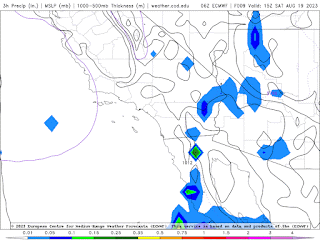Good evening weather enthusiasts!
Synopsis:
Hurricane Ian tore across Western Cuba, strengthened to a strong category 4 major hurricane before
slamming into Cape Coral, Florida with catastrophic winds and devastating storm surge and flooding up to 16' in places. The storm is now east of Jacksonville, FL over the Atlantic where the tropical engine continues to steam on, having recently downgraded to Tropical Storm status for a short time before strengthening and organizing into a category 1. The storm now has its eye fixed on Charleston, SC and is moving nearly due north at 10 mph.
While the storm itself isn't as "perfectly formed" as we normally think of a hurricane, the Gulf low expressed in the form of hurricane Ian is interacting with the Canadian High pressure system to create an effect we refer to as Cold Air Damming (CAD) in the winter months. That's part of the reason we've had some beautiful fall weather to start the season, and part of the reason this will be such a rain event.
The cold pool we've been experiencing is stable air... cold air sinks, warm air rises. Well, now we have a tropical air mass advecting warm, moist air into an already stable atmospheric situation. This is causing a coastal warm frontal effect and "transforming" (if you will) this banded precipitation into a more uniform, stratiform, convective rainfall event.
Expectations:
Let's talk first and foremost what we can expect from this system. It is moving north northeast at approximately 10 mph on last observation, and has a rain shield extending northeast over 300 miles from the center of circulation. Parts of NC, especially eastern NC out by the coast, are experiencing drought conditions, so the benefit of this rain is that should be alleviated. The unfortunate part of it all is we will likely have localized flooding from storm surge at the coast in addition to rain. Numerous counties are under a Tropical Storm Warning by the National Weather Service, and counties are wisely closing schools and activities for tomorrow to protect their students, staff, and parents.
Rain Totals
Coast/Coastal Plains/Sandhills: While models are having difficulty getting a read on exactly how much rain can be expected, they're in agreement that there will be heavier precipitation along the coast from New Bern down through Wilmington and into Myrtle Beach, then continuing into the Sandhills until Fayetteville. These areas can expect anywhere from 5-8" of rain. This bullseye in the sandhills could shift west over toward Charlotte depending on the westward movement of Ian.
Piedmont: The Piedmont generally north of I-40 and west of I-95 can expect slightly less by way of precipitation - about 3-5"
Foothills: The foothills will get anywhere from 2-4" depending on the westward push of Ian as it moves north into the Carolinas. The further west, the more rain for the foothills but generally between 2-4" can be expected.
Elevation: Similarly to the foothills, 2-4" could fall.
Storm Surge
What is storm surge? It's essentially the height the ocean level increases as a result of the storm. A hurricane is a low pressure system, meaning the atmospheric pressure is lower than normal. Water pressure in the ocean, however, stays relatively constant in comparison.
As a result, when this low atmospheric pressure moves over constant ocean pressure, the ocean literally bulges up underneath the storm, creating swells. The extent of those swells due to how strong the wind field is creates a wave fetch, which we try to determine the socioeconomic impact based on shoreline geography, population density, elevation, etc.
Long story short, the OBX and coastline won't experience nearly the storm surge that Gulf Florida did, however there could still be damage from the 3-5' expected along the coastline. Further South near the strongest winds and center of rotation, storm surge between 5-7' could be experienced. This surge is likely to cause some beach erosion, flood the first floors of buildings not on posts, and move around vehicles, yard furniture, and watercraft. Winds in excess of 70 mph will aid in this shifting of belongings and will likely fell trees and cause minor damage to roofs.
Hazards:
1. Flooding: make sure you have potable, bottled water in the event of flooding of your home, contamination of city water, or contamination of well water.
2. Wind Damage: Wind can be devastating when paired with water. Tall trees, shallow root structures, and saturated soil here in the deciduous forests could cause plenty of toppled trees, damaging property and cutting power to tens of thousands. Be sure your vehicles are parked in a safe place out from any trees, and please do NOT stay in your car underneath tree limbs.
3. Power Outage: While things won't be as widespread as Florida, our infrastructure is not well-equipped for this type of system and unfortunately the power can go out easily with a felled tree or power pole. Make sure your extra battery packs for your phone are charged, and have a healthy supply of batteries in the event that flashlights become the source of light.
Remember a couple last things: Turn Around, Don't Drown! If you can't see the roadway, don't try to drive over the road. It only takes a couple inches of water to move your sedan. Secondly, Prepare for the worst, hope for the best. Have your hurricane emergency kit ready to go and in an easily accessible place.
Thanks for reading, and keep your eyes to the skies!
























